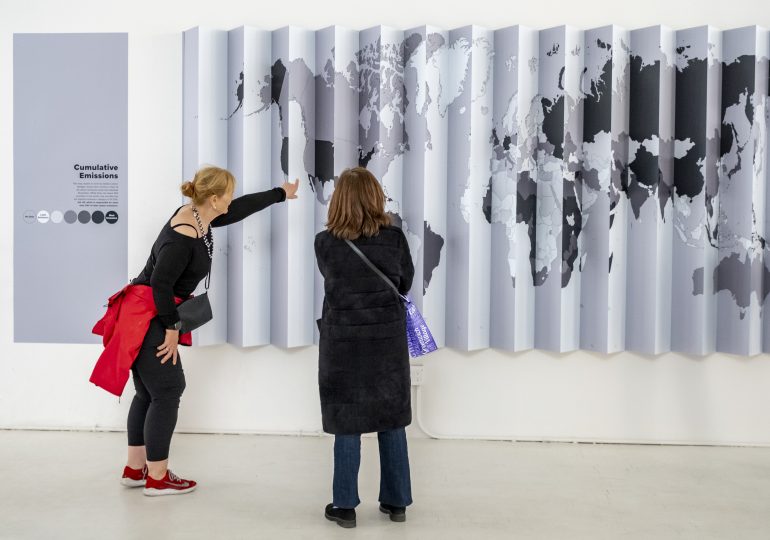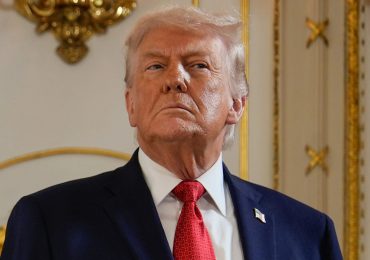The first piece of art attendees will see as they head to the Climate Museum’s latest exhibit is a map of the world in black, white, and gray.
At first glance, the map presents which countries are producing the most emissions, with those emitting the most showing up black and those the least in white. But once the viewer moves to the right, the map is revealed to be a lenticular print—a piece of 3D art in which perspective changes the view entirely. From the right side, the map shows how vulnerable each country is to the impacts of climate change, and the countries that were once in black are now in white, and vice versa.
[time-brightcove not-tgx=”true”]
The impact of the map can only be seen once the viewer moves. In other words, viewers cannot stand still—they have to choose to see the inequities the map is showing.
The map reveals a key strategy by the Climate Museum, which installed the piece at The Nest Climate Campus at New York City’s 2024 Climate Week: imbuing viewers with agency to interact with art, in hopes they’ll then take action in the climate crisis.
“We combine art with learning opportunities and calls to action in such a way that visitors come out of the show seeing their own agency and ready to take action in a new way,” museum founder and director Miranda Massie tells TIME. “This very simple formula is astoundingly effective at helping people understand themselves as agents of change.”
Massie says that the creation of the museum—the first dedicated to climate in the United States—came in part from seeing the “superpowers” of museums as cultural institutions with both high levels of public trust and popularity, assets that are particularly valuable to tackle an issue rife with misinformation and partisan divides while trust in public institutions overall remains low.
Read More: How Public and Private Sector Leaders Are Tackling Climate Equity
To that end, the Climate Museum has a specific audience in mind for the lenticular map and other pieces of art, including a towering 70-foot-mural telling the story of past industrialization and an envisioned positive future titled “Making Tomorrow” by artist R. Gregory Christie. Massie says the team typically directs their exhibitions to members of the public who researchers from George Mason University and Yale University call the “alarmed”—those most concerned about climate who are inactive yet willing to be engaged.
“We need worried people to be more actively engaged and to recognize their own agency,” Massie says. “A museum is a way of doing that that can advance that purpose and therefore support progress on climate policy.”
According to Anais Reyes, senior exhibitions associate at the museum, this is where the art comes in. It’s an “entry point” for people to respond to what they see and feel, to try to open themselves up to understanding that they are not alone in their fears of the climate crisis.
A key example of an installation that encourages viewers to participate in the work is the sticker wall. There, at the end of scheduled programming or when people happen to wander over, participants are asked to place a sticker on a blank wall, stating what they can commit to doing to combat climate change. “I will talk about climate justice,” one says. “I will tell people about the climate supermajority,” another reads, referencing a study showing that while 66%-80% of Americans support policies that mitigate the climate crisis, Americans estimate that number to be only 37–43%.
At Climate Week, what was once an empty wall is soon covered in commitments.
“The sticker wall started as a way to represent the collective, to represent how you might feel alone in this, how you might feel [an] existential threat, but really, there are so many people that feel the same way as you, and we’re all connected, and we’re all trying to make things better,” Reyes says.
Yet as the museum tries to inspire viewers to enact change, it’s engaged in its own struggle to attract funding for a permanent home. The museum, which held its first exhibit in 2018, still doesn’t have a building or long term space for its exhibits. Its booth, programming, and art at the Nest’s Climate Campus for Climate Week, which runs from Sept. 22 until Sept. 29 at the Javits Convention Center in Hudson Yards, Manhattan, shares a space with multiple other organizations including General Motors. “We’ve had a tremendously difficult time coming into existence and staying in existence, and we have not been able to grow in a way that matches public interest in our work, and that is profoundly wasteful,” Massie says. In 2022, less than two percent of philanthropic funding worldwide went to climate crisis mitigation, according to a study done by Climate Works Foundation.
Despite reasons for despair in both the climate crisis and museum fundraising, the Climate Museum also prioritizes hope. During the museum’s Climate Week programming on Sept. 24, Nicholas Badullovich, a researcher from George Mason University, presented findings from a study on the museum’s previous exhibit, “The End of Fossil Fuel,” that determined people left feeling hopeful, even though the exhibit presented tragedies related to the climate crisis, the fossil fuel industry, and climate injustice.
“We’re not here to sit in the doom and gloom,” Reyes says. “We’re here to envision that better future, to acknowledge that there are many things that can be done, and we all just need a little bit of direction to channel that way into something productive, into something hopeful and actionable.”
Leave a comment








